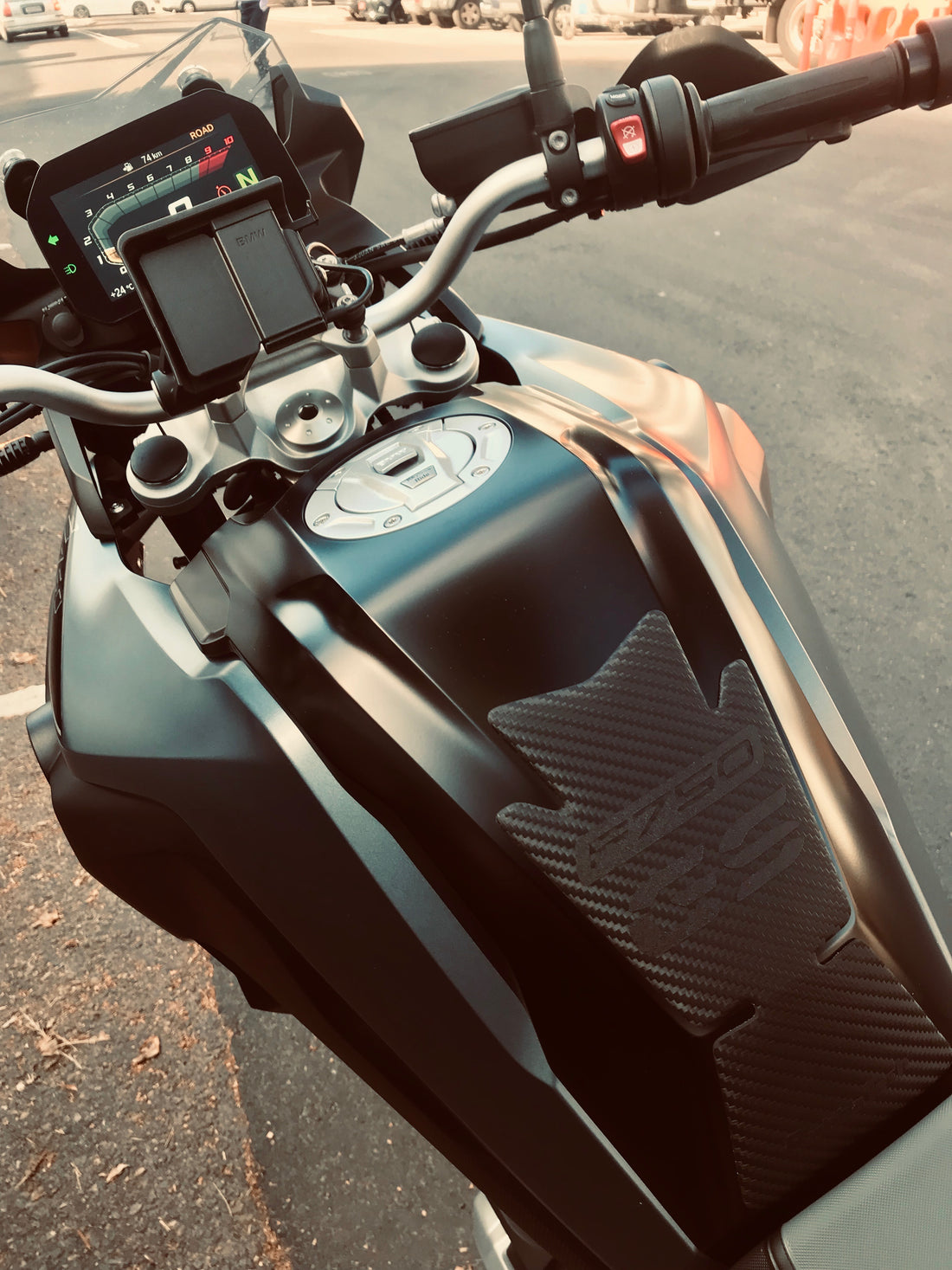In this article, we will guide you through Motorcycle Tank Grips 101, helping you understand the important factors to consider when choosing the right grip for your bike. From material to design, we'll explore the different options available to suit your riding style and preferences.
Our experts have researched and tested various tank grips to provide you with the most comprehensive information. We will also showcase some of the top brands in the market and their unique features. So whether you're a sportbike enthusiast or an adventure rider, this article will help you make an informed decision.
Don't compromise on control and comfort. Read on to learn more about how to choose the perfect motorcycle tank grips for your bike.
The importance of motorcycle tank grips
The grip you have on your motorcycle's tank is crucial for maintaining control and stability. It not only provides a secure hold but also reduces fatigue and enhances your overall riding experience. When you have a solid grip, you can maneuver your bike with confidence, especially during cornering and braking.
Additionally, tank grips help to absorb vibrations, reducing strain on your wrists and arms. This is particularly important for long rides or when riding on rough terrains. By minimizing the impact on your body, tank grips can prevent discomfort and fatigue, allowing you to ride for longer periods without sacrificing comfort.
Different types of motorcycle tank grips
There are various types of motorcycle tank grips available in the market, each offering different levels of traction and comfort. Here are some of the most common options:
1. Rubber Tank Grips: Rubber tank grips are popular among riders due to their excellent grip and durability. They provide a secure hold even in wet or slippery conditions, making them ideal for riders who often encounter challenging weather or road conditions.
2. Silicone Tank Grips: Silicone tank grips offer a softer and more tactile feel compared to rubber grips. They provide excellent grip and are known for their vibration-dampening properties. If you prioritize comfort and prefer a cushioned grip, silicone tank grips may be the right choice for you.
3. Grip Pads: Grip pads are adhesive-backed pads that can be applied to your motorcycle's tank. They come in various shapes and sizes, allowing you to customize the grip according to your preferences. Grip pads are a versatile option as they can be easily removed and replaced if needed. They are also available in different materials, such as rubber or textured vinyl, providing a range of grip options.
Factors to consider when choosing a motorcycle tank grip
When selecting a motorcycle tank grip, several factors should be taken into consideration to ensure the best fit for your bike and riding style. Here are some key factors to keep in mind:
1. Material: The material of the tank grip plays a vital role in its performance and durability. Rubber and silicone are popular choices due to their excellent grip and longevity. Grip pads made from high-quality materials can also offer good traction and durability.
2. Design: Tank grips come in various designs, ranging from simple patterns to intricate textures. Consider the design that suits your aesthetic preferences while also providing the required grip. Some designs may feature perforations or grooves to enhance grip and ventilation.
3. Size: Ensure that the tank grip you choose fits your motorcycle's tank perfectly. Measure the dimensions of your tank accurately to find the right size. An ill-fitting grip may not provide optimal grip or may peel off easily.
4. Installation Method: Different tank grips may require different installation methods. Some grips may need to be glued or adhere using adhesive backing, while others may have a self-adhesive backing. Consider your skill level and the ease of installation when choosing a tank grip.
5. Maintenance: Consider the maintenance requirements of the tank grip. Some grips may be easier to clean and maintain than others. Opt for grips that are resistant to dirt and easy to clean, ensuring they remain in good condition for longer.
How to measure your tank for a perfect fit
To ensure a perfect fit, accurately measuring your motorcycle's tank is crucial. Follow these steps to measure your tank for a tank grip:
1. Clean the tank surface thoroughly to remove any dirt or debris.
2. Use a measuring tape to measure the length, width, and height of the tank.
3. Take note of any curves or contours on the tank's surface that may affect the grip's fit.
4. Based on the measurements, choose a tank grip that matches the dimensions of your tank.
Remember, a proper fit is essential for optimal grip and longevity of the tank grip. Avoid choosing a grip that is too small or too large for your tank.
Rubbatech™ pads (tank pads, knee pads and pannier pads) are all individually hand made from an ultra strong and durable rubber, with extremely high abrasive resistance and UV stability. We strive to produce a product that does not only give maximum and effective protection, but also with unique styling and non ageing appearance.
All Rubbatech™ pads use a clear PVC application tape, with a glue stability range from -10 up to 100 degrees Celsius. We believe you will have many happy kilometers with Rubbatech!
Proper installation and maintenance are essential to ensure the longevity and performance of your motorcycle tank grip. Follow these steps for installation and maintenance:
Installation:
1. Clean the tank surface thoroughly using a mild detergent or alcohol-based cleaner to remove any dirt, oil, or residue.
2. Measure and mark the position where the tank grip will be placed, ensuring proper alignment and fit.
3. If the tank grip has an adhesive backing, carefully peel off the protective layer and align it with the marked position on the tank.
4. Apply even pressure to the grip to ensure it adheres properly to the tank surface.
5. Smooth out any air bubbles or wrinkles using a soft cloth or your fingers.
6. Allow the adhesive to cure for the recommended time before using the motorcycle.
Maintenance:
1. Regularly clean the tank grip using a mild detergent or specialized grip cleaner.
2. Avoid using harsh chemicals or abrasive materials that may damage the grip's surface.
3. Gently scrub the grip with a soft brush or cloth to remove any dirt or debris.
4. Dry the grip thoroughly before riding to prevent slipping.
By following these installation and maintenance tips, you can ensure your tank grip remains in optimal condition for longer, providing you with the best grip and control.
Using a motorcycle tank grip offers several benefits that enhance your riding experience. Here are some key advantages:
1. Improved Control: A tank grip provides a secure hold, allowing you to have better control over your motorcycle. It prevents your body from sliding forward or side-to-side during acceleration, braking, or cornering.
2. Reduced Fatigue: By absorbing vibrations and reducing strain on your wrists and arms, a tank grip helps to minimize fatigue, allowing you to ride for longer periods without discomfort.
3. Enhanced Safety: With a reliable grip, you can confidently maneuver your motorcycle, reducing the risk of accidents and improving overall safety.
4. Comfort: Tank grips offer a cushioned and tactile feel, reducing discomfort during long rides. They also help to distribute your body weight evenly, reducing pressure points.
5. Personalization: Tank grips come in various designs and textures, allowing you to personalize the look of your motorcycle while also improving functionality.
By investing in a quality tank grip, you can enhance your riding experience by improving control, comfort, and safety.
To ensure you make the most of your tank grip, consider the following tips:
1. Proper Riding Position: Maintain the correct riding position by gripping the tank with your thighs and knees. This will provide additional stability and reduce strain on your upper body.
2. Regular Inspection: Periodically inspect your tank grip for any signs of wear and tear. Replace it if necessary to maintain optimal grip and safety.
3. Avoid Harsh Chemicals: When cleaning your tank grip, avoid using harsh chemicals or solvents that may damage the surface. Stick to mild detergent or specialized grip cleaners.
4. Practice: Familiarize yourself with the grip's feel and traction before embarking on long rides or challenging terrains. Practice your grip and control on familiar roads before pushing your limits.
5. Consider Weather Conditions: Different tank grip materials may perform differently in various weather conditions. Consider the weather conditions you often ride in and choose a grip material that offers optimal performance.
By following these tips, you can optimize the effectiveness and longevity of your tank grip, ensuring a safe and enjoyable riding experience.
To help you make an informed decision, let's compare the different grip materials commonly used for motorcycle tank grips:
1. Rubber: Rubber tank grips offer excellent grip and durability. They are resistant to wear and tear, making them suitable for riders who frequently encounter challenging road conditions. Rubber grips provide a secure hold even in wet or slippery conditions.
2. Silicone: Silicone tank grips offer a softer and more tactile feel compared to rubber grips. They are known for their vibration-dampening properties, reducing fatigue and increasing comfort. Silicone grips are ideal for riders who prioritize comfort and prefer a cushioned grip.
3. Grip Pads: Grip pads provide versatility and customization options. They are available in various materials, including rubber and textured vinyl. Grip pads can be easily removed and replaced, allowing you to experiment with different grip patterns and materials according to your preferences.
Consider your riding style, weather conditions, and personal preferences when choosing a grip material. If you prioritize durability and grip, rubber grips may be the best choice. If comfort is your priority, silicone grips offer a softer and more cushioned feel. Grip pads provide the flexibility to switch between materials and patterns.
Choosing the right motorcycle tank grip is essential for optimal control, comfort, and safety. Consider factors such as material, design, size, installation method, and maintenance requirements to make an informed decision. Measure your tank accurately for a perfect fit and explore popular brands known for their quality and performance.
Proper installation and maintenance are crucial for the longevity and effectiveness of your tank grip. Regularly clean and inspect your grip to ensure it remains in optimal condition.
By investing in a quality tank grip and following the tips and guidelines provided, you can enhance your riding experience and enjoy improved control, comfort, and safety. Don't compromise on control and comfort—choose the perfect motorcycle tank grip for your bike today.
Remember, a secure grip leads to a confident ride!

